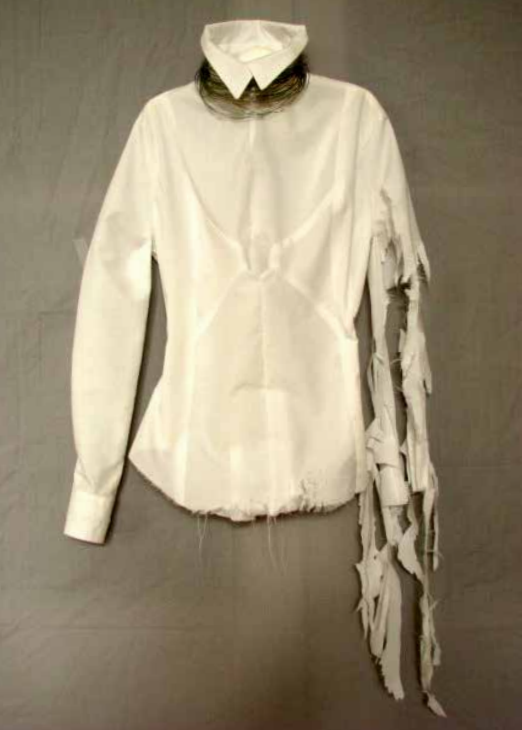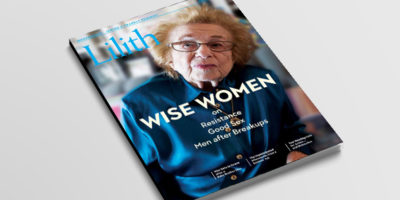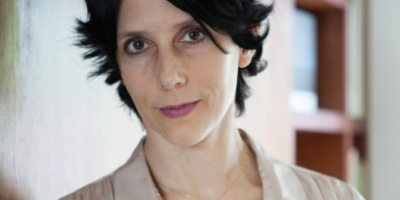
Giving Away Grief
A writer in the City of Eternal Peace confronts the death, decades earlier, of her baby brother.

“MOURNING KITTEL” BY JACQUELINE NICHOLLS
Finally, I could accept Joey’s death, because I had settings and characters that grounded me in time and place. Even if some of the details were wrong, the chronicle offered a good enough story for me to believe I had a viable past.
My fiction writing had forced me to understand that the trauma at mid-century had been not only my parents’, but also mine. Joey’s birth and death were a family trauma, even though the grown-ups tried to hide the facts and feelings from the children. Involuntarily, I had become the keeper of Joey’s memory and my mother’s sorrow, absorbing her silent grief like a sponge and holding it inside for more than four decades. Now it was time to transfer ownership. So when my mother came for a visit for her 75th birthday, in 1995, I planned to bring her to my writing room after our birthday lunch and give her a special gift.
“You have his death certificate?” My mother’s question gets tangled around her canines while she nibbles at a wheat berry, black bean and celery salad. We’re celebrating her 75th at a trendy Jerusalem restaurant on Emek Refaim Street—Valley of the Ghosts or Valley of the Giants, depending on the historical context. Today’s context is a mishmash of Gigantic Ghosts and Ghostly Giants.
Everything in the restaurant—the chairs, tables, floor, walls, plates, napkins, menus—is either pastel turquoise, or pastel peach. It’s the same décor as the nursing home in Florida where my father died three years ago, drifting in and out of consciousness for three days while my mother searched for ways to absent herself from the moment of death. Want to go to McDonald’s? she had asked me, on the last night of his life. I had flown in from Jerusalem to oversee the final step of my father’s transition from giant to ghost.
I tell her I have the Certificate of Death as she sticks two fingers with beautifully polished nails into her mouth to dislodge a sliver of celery. “I want you to have it.”
What I don’t tell her is that I want to step out of the past and shut the door, like those tourists across the street who are shutting the green iron door to the Templar Cemetery behind them. It’s time. Giving my mother the Certificate of Death may seem an untidy birthday gift, but I don’t know where else it belongs.
Your mother has class, my friends have been telling me for years, every time they see her at a brit or bar mitzvah. At 75, her frosted, cropped hair frames her oval face like solid hands. An elegant peach-and-turquoise silk scarf wrapped around her neck holds her face aloft—a small pedestal supporting the head of a marble Demeter, one with vibrant gray-green eyes, her own white teeth, and smooth Hungarian skin. (For me it’s all White Russian wrinkles.) My mother carries herself with a strong, independent bearing, but I wonder now, as I plan to give her this gift, if her strength is fragile. Does the frailty my father used as a reason to protect her from her bereft children the day Rabbi Green came to the house, and forever after, lurk beneath?
“I wrote to the Division of Vital Statistics in Akron,” I say, looking down at my tuna salad and then up again, trying to maintain a matter-of-fact stance. “After your letter, I needed more facts.”
She’s listening, although her eyes are focused on the Italian parsley caught on the tip of the fork in her hand.
“For seven dollars, or seven fifty, I don’t remember, they sent me… our past,” I say.
“What?” She drops the fork onto her plate. “Whose?”
I look out the window to the Christian cemetery across the street. German Templars who came to Jerusalem in the 19th century are buried there, as well as other Christians who came later and “Fell asleep in Jesus” or “Passed to the New Jerusalem.” The stones are engraved in Hebrew or Arabic, English, German, Dutch, Russian, Greek, Chinese. Perhaps this cemetery, and not the décor, is the reason I chose this particular restaurant. It helps me focus on my mission—giving back the grief, the secret story manifested in the Certificate of Death. My body is no longer a vessel for Joey and my mother’s sorrow. No longer will Joey live in my muscles, chest and back, where he solidified, causing a breathing tic on the inhale. Fortunately, I recognize this now and am shaking it loose.
“Do you want it?” I ask, shocking us both.
The waitress walks by and smiles. My mother asks for water. “Why don’t they bring it with the meal?” she asks, even though she’s visited Israel 10 times and knows water is never served unless requested. “You haven’t touched your salad, Judy. Don’t you want to eat?”
I turn back to the green iron door. Despite the life-affirming Zionist experiment over the last hundred years, I see Jerusalem as a city of the dead. For two thousand years, old Jews came here to die, not to live. Even today, some dying Jews abroad request they be buried in Jerusalem. Jerusalem is “the city besieged by [an] army of the dead,” wrote Herman Melville in 1857. “Jerusalem is mournful and dreary and lifeless.” This is Mark Twain, 10 years later: “I would not desire to live here.”
The City of Peace refers, actually, to the city of eternal peace. This is the Jerusalem that pulled me in when I was young. Jerusalem calls to those in search of the past. From the oldest Jewish cemetery in the world on the Mount of Olives in the east, to the far newer Jewish cemetery in Givat Shaul in the west, from the tombs of King David and the Prophet Samuel on the hills, to the Catholic and Protestant tombs of Jesus in the center, and in the center of the center, where an ancient stone wall is watered with tears, its chinks filled with handwritten notes to God, Jerusalem’s stones embody national and religious grief. Come back, the city calls. Mourn.
I know my mother does not want to hear this version. She prefers the Israel Museum and the Knesset. She wants water and a toothpick. With a flimsy napkin she dabs the corners of her lips, takes her mirror and lipstick from her purse and applies “Spring Peach.” I pay the bill.
“We’re going to your writing room now?” she asks and I detect a reticence she would never express directly, as she does not want to hurt my feelings.
“Yes,” I say, with forced assertion, as my doubts begin to rise. We head north on Valley of the Ghosts. My mother walks with a youthful bounce. I walk slower, lugging our pasts. She marvels at all the jewelry stores on the street. Maybe I should be giving her a proper 75th birthday gift—like opals or pearls.
She asks about the hill in the distance across the valley.
“That’s Mount Zion,” I say, looking at the iconic hill, “as in,” and now I stop to sing in a pseudo-operatic voice Cantor Bushman’s version of the verses from Isaiah, Come ye and let us go up to the mountain of the Lord, Unto the House of the God of Jacob. And He will teach us of His ways. And we will walk in His paths, for out of Zion shall go forth the Law and the Word of the Lord from Jerusalem.
“Oh, my,” she says. “You remember all that? Doesn’t look like much from here.”
“It moved me once,” I say. We start to walk again. “How much longer do we have?”
We pass the railroad station that, since 1892, has connected Jerusalem to the rest of the world, serving as her lifeline, enabling her to sit not entirely alone. We turn right onto Hebron Road and then left, up an alley into Abu Tor, Father of the Bull. My writing room is one of three rooms in a shared rent- al of a basement apartment on Nachshon Street. In the Oral Tradition, during the Exodus from Egypt, Nachshon waded into the Red Sea until the water reached his nose. Only then did God split the sea for the Children of Israel. I used to want that kind of faith, Nachshon faith, but I’ve lost the desire. All I want now is freedom from mourning and compulsive retrospection. All this I do not tell my mother.
“I hope you have a bathroom,” she says.
We enter my stark white room. At one end is a white table the length of the white wall, at the other end a new Simmons Hide-a-Bed, off-white. On the floor is a new white carpet, low pile. The design impulse came from Florida. I wanted to feel close to my mother, who lives in Sarasota amid manicured lawns, magnolias and crotons, where neighborhoods of peach-colored one-storey houses carry names like Crystal Lakes and Palm Aire; where the old go— not to die and mourn, but to enjoy the good life in posh rooms with white walls, white carpets and white leather chairs.
As we stand together in my sparse white room, afternoon light strains to penetrate dirty gray windows at the top of the far wall and I do not feel close to my mother.
She goes to the bathroom while I look at the Joey file. It bulges from white binders that stand like sentinels along the white table.
“How do you flush?” she asks when she returns, walking towards the Hide-a-Bed. She sits down. I go flush for her, come back and stand next to the binders. “Nice fabric,” she says rubbing the white polyester and wool armrest. Her left hand moves in small counter-clockwise circles and her right hand rubs the cushion next to her in clockwise circles, both with intent. Is she treading water? Does she feel like she’s drowning, or is she hoping, with all this rubbing, to feel something new?
I remember rubbing her red chinchilla coat on a winter afternoon. Maybe it was January 1951 after Joey left the house when I was five and a half and in kindergarten at Ludlow School, or late February, after Joey died. Maybe it was January 1952, after Jimmy was born and I was in first grade, and maybe the when doesn’t matter. All that matters is we shoveled snow together, clearing the deep snow from the path leading from the front door on Ludlow to the outside world. With longing I remember that day; the searing, blinding white snow, the red Scottish plaid scarf wrapped tightly around her neck, her brown leather gloves, the strength with which she held the shovel, the ease with which she threw the snow to the sides, not looking at me as I, holding my toy shovel, stared at her, wanting to be like her, to be held by her, to feel close to her, to be her.
Is she thinking of snow now as she rubs my white couch?
If I had rubbed her red chinchilla coat long and hard enough, would I have been able to touch her?
“Nice fabric,” she repeats. “How much did you pay?”
I pour out the Joey papers onto the desk. The scrambled papers look like a composition of artifacts from some minor genizah, a hidden archive. Here is the letter from Rabbi Green and the form from Billow Funeral Home and Crematorium. Here is my mother’s letter on yellow legal pad paper. Can this distant woman sitting on my couch be the same one who penned that warm, open letter? Here are the photocopies of microfiche pages from The Cleveland Plain Dealer from 1949, 1950 and 1951, the cover of the Lowell sheet music of “Joey,” my notebooks filled with writings and rewritings of memories, fictions and what ifs, drafts and rewrites of drafts from Mount Zion, A Chronicle, as well as earlier versions, Diving into Mount Zion and Primary Sources.
On the back of an envelope are lines I transcribed from Adrienne Rich’s “Diving into the Wreck:”
We are, I am, you are
By cowardice or courage
The one who find our way
Back to this scene
Carrying a knife, a camera
A book of myths
In which
Our names do not appear.
“What are you looking for?” my mother asks, fiddling now
with her purse.
“The Certificate of Death. I want to give it to you.” “Well…if you think so,” she says, looking at her watch. Nine months to the week after Joey died, my mother gave birth to Jimmy, a healthy, blond baby who, like the biblical Joseph, saved the family. Grandma was in place in the upstairs bedroom. Vashti the maid came four times a week to clean floors and mangle sheets. Mother and father now had the time, energy and mental health to learn the rhumba and cha-cha, to bowl and golf, to vacation in Puerto Rico, St. Thomas, Mexico and the Virgin Islands. My mother brought me dolls from each country. They sat on a glass shelf in a shadow box over my bed. These were the angels who looked down upon me and protected me while my mother played mah-jong, canasta and bridge.
Once Jimmy was born, we became the iconic 1950s Midwest American family: Father worked hard and earned well; Mother became president of the PTA; well-behaved little girls learned plié and piano; little boys learned to bat. We ate dinner together: meat, green beans and mashed potatoes, followed by red Jell-O or vanilla junket.
I find the certificate and read it for the last time. I am good at reading it now. I don’t even gulp the way people do to suppress an uncomfortable feeling. I no longer read into it. Now, 44 years after Joey’s death, the certificate has become a bureaucratic form, every detail, even the category for survivors, where my name does not appear. Dry text, albeit stained with tears. Holding it in my hand I turn towards my mother, who is now kneeling on the white rug and rubbing its pile. I kneel opposite her, hand steady, telling myself it is okay to give my mother her son’s Certificate of Death.
“Here it is, Mom,” I say. I hold it out to her as one might make an offering to a goddess, praying for mercy and long life.
She takes it with one hand and says “Nice rug,” as she slowly pushes herself up with her empty hand. Standing, she looks at the form, trying to focus on the small print. She could take her reading glasses from her purse, but chooses not to. She squints at the paper as if it might be a shard from a foreign land, some mysterious document—the Word of the Lord from Jerusalem? A relic from the days when the Lord reigned from Mount Zion? Her eyes ask, how did this get here? The fingers of her right hand rub the paper, front and back, back and forth, and suddenly I wonder: Is the purpose of all this rubbing to access feeling? To feel?
Or—and the thought astounds me—to erase, like Lady Macbeth’s futile attempt to blot out the blood spot? I cannot read my mother. Suddenly, I am overcome with sadness and guilt. The giving feels cruel.
My mother moves to the couch, sits down, and folds the paper into her purse. In a soft voice, barely audible, she says, “We never had a photo….”
I look into her damp eyes and feel sorrow and compassion. I move to kneel at her feet. I want her to put her hands on my head and bless me, and at the same time I want to hold her in my arms and rub her head the way a mother might. There, there, sweetheart. Everything will be alright. Her face is full of confusion, but even confused, she is stunning, her gray-green eyes now moist, deep un-verbalized feeling expressed only in a watery film.
I stand up, walk to my desk and turn towards her. She is standing now, too, walking towards me, asking what percentage of the rug is wool. She whispers, “I bought candlesticks.”
Judy Labensohn is a writer, teacher of creative writing and a hairdresser. She lives in Tel Aviv.



